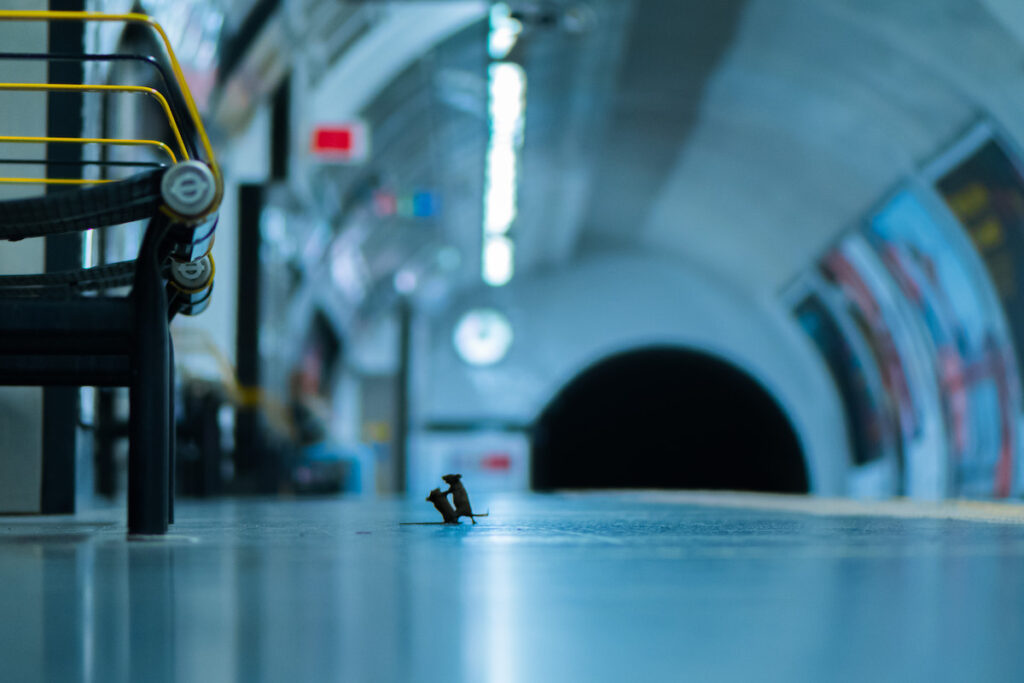"Station squabble" is the title of this wildlife image by photographer Sam Rowley. In this post, we explore some basic visual literacy principles for teaching with images.
You might remember this photograph from earlier this year. Like many people, I think I thought that the tiny subject – two mice on a platform in the London Underground – were dancing.
But the supporting text told me otherwise. The title of the image is “Station squabble” and, according to photographer Sam Rowley, the mice are fighting over a scrap of food left by a passenger.
The picture was the winning entry for the Natural History Museum’s Wildlife Photographer of the Year, People’s Choice Award. It immediately went viral. And after seeing it featured in news reports and websites all over the internet, I started to wonder: What if there was no photographer’s account to qualify the image? What sort of stories would we create about it?
An experiment
These questions gave rise to a simple experiment that I shared in the Lessonstream Membership. Teachers showed the image to their students and asked them to write about it in the absence of any sort of influencing information – a standard approach to teaching with images. In other words: “Here is an image. Say what you see.”
The results were interesting. First of all, there was a divergence of ideas relating to the location. Some students decided that it was a science laboratory. There were also museums, halls, factories and a hospital.
There was also a lack of agreement about the subject. Although most students identified the two mice and referred to them in their texts, others spoke about shadows or “unidentified small animals”.
A considerable number of students made no reference to any subject at all and described the location only. Had they failed to see the mice? Perhaps so. Sam Rowley’s photograph goes against the norm: we expect subjects to fill the frame and dominate the composition. In this case, however, our eyes have to work to find the mice and work out what’s going on. And when they do so, the payoff is the delightful impact that comes from the originality of the image.
Most notably, there was a lot of variation in narrative. Students decided or speculated that the mice were doing any and all of the following:
- Fighting
- Helping each other
- Proposing (“Will you marry me?”)
- Looking for cheese
- Dancing
- Mating
Some example stories
Let me give you a few student stories that came from this activity:
One mouse is hitting the other mouse by the bench. Maybe a mother hitting her son angrily. Why is mother angry? She is angry because her son got to the station late and they missed the train.
The mouse was proposing to his girlfriend when he got squashed by a factory worker.
Late night underground station. Two mice mating. Mind the gap!
The subway station is empty. There is no one around. On the platform, there are two mice dancing in the light. They dance silently. The whole world is their stage.
It has been said that we all want a story with a happy ending. Perhaps the heavily romanticised interpretations from some students are symptomatic of this.
The photographer’s words
On Sunday 24th May, photographer Sam Rowley joined us for a guest webinar in the LessonSteam Membership during which he shared his story behind the image.
Despite the success of his photograph, Sam seemed to speak with just a little bit of regret at the fact people tend to see it as cute or whimsical.
“We have created this dark and hostile underground network of tunnels. These creatures survive in a world that should be have been alien to them. They are strangers to sun, grass, day and night. And they are completely reliant on us. This is an image of desperation and what desperation drives us to do. And now, during this time of social distancing and lockdown, conditions for these animals must be nothing less than apocalyptic.”
They say that every picture tells a story. But they are wrong. Any picture can be associated with an infinite number of constantly developing and changing narratives. Importantly, we are the ones who create the stories – not the pictures. And the stories that we create, depend on who we are, what we see, how much we look and what we know. When teaching with images like this one, getting students to consider and compare different narratives is fundamental to developing visual literacy.
Note: this article was originally shared as a LessonSteam Post. Click below to sign up for free. For discussion, join the LessonStream Facebook group.



